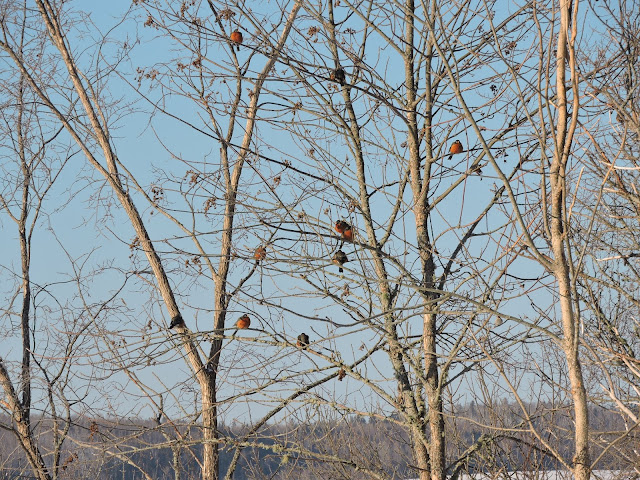Flocks of Robins
 |
| American Robin |
Large flocks of robins are moving through our area now in late October. All this week almost any time I look out my window I can count 25 robins feeding on our lawns and field. They are turning over leaves and searching among the blades of grass for insects and worms. Often I see one pop up into the air as it is displaced by another. They seem very busy, excited even. They fly frequently between the ground and close-by trees. Where are these birds coming from and where are they going?
 |
| Many Robins Perched in Our Trees |
The American Robin (Turdus migratorius) is our most common thrush. They are a member of the Turdidae family which they share in this area with the Eastern Bluebird, Veery, Hermit Thrush, Swainson's Thrush and others. Yes, there are other 'robins' but most are vagrants which wander onto our continent from South and Central America or Siberia; for example, the Clay-colored Robin, the White-throated Robin and the Rufous-backed Robin.
 |
| American Robin |
The American Robin is so familiar to us it doesn't need description. This species' habit of living near our dwellings, its pleasing song and its generally confident nature make it one of our favourite species.
Like many other species, the males tend to be brighter in colour and the females grayer but there is so much overlap one cannot determine genders by appearance alone. An interesting fact is that the western race is generally lighter in colour than our eastern race. Our birds are mostly brightly coloured. The young show spotting on the underparts as we are all familiar with. It is fun to watch the flocks which we are seeing now for juveniles. They are obviously trying hard to learn 'the ropes', how to find food, how to cooperate with the rest of the flock.
 |
| American Robin |
The American Robin inhabits all of North America except the Arctic islands. It is a short and a medium-distance migrant. They spend their winters in most of the US states but most go to the middle and southern states and Mexico. A few stay here in New Brunswick for the winter. We always count a few on Christmas Count Day. In each of 2016 and 2017 we found one in Douglas and in 2015 we counted 40 in Douglas. Some of that large number were probably just late migrating and would move south.
 |
| American Robin |
The large flocks of robins we are seeing now are migrants. They have generally come from somewhere else and are moving through on their way south. I have tried to speculate where they have come from. In my opinion many of these birds are from Quebec and northern New Brunswick. I also think some flocks are from western Newfoundland and have flown across to Gaspé and other parts of Quebec. They then fly down the St. John River on their way south. Birds tend to use waterways and shorelines to help direct their flight paths. No matter how they got here and wherever they are from, we certainly enjoy their visit while they rest and refuel. Safe journey little cheery friends!











